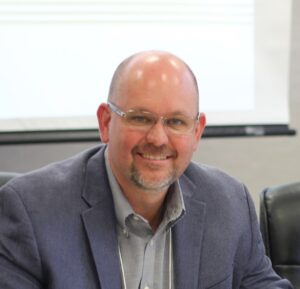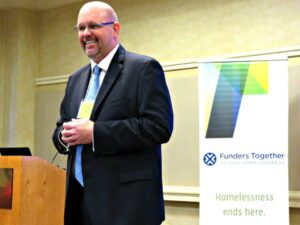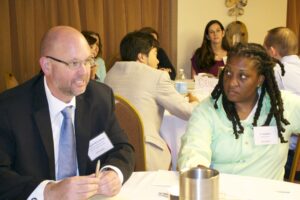News
From Business Owner to Philanthropist and Advocate
 Most members of Funders Together to End Homelessness represent institutional philanthropy — private, endowed foundations; community foundations; corporations; or United Ways. Yet the vast majority of charitable donations in the U.S. come from individuals and it has been a goal of Funders Together for a number of years to increase membership among individual philanthropists.
Most members of Funders Together to End Homelessness represent institutional philanthropy — private, endowed foundations; community foundations; corporations; or United Ways. Yet the vast majority of charitable donations in the U.S. come from individuals and it has been a goal of Funders Together for a number of years to increase membership among individual philanthropists.
A shining example of the power of individual philanthropy is demonstrated by Michael McConnell, who became a Funders Together member in 2012. Michael was a successful small business owner in San Diego and became interested in addressing homelessness, which was becoming more prevalent in his community. This wasn’t an arms-length endeavor for Michael though; he quickly dove in by not only donating funds, but also spending a lot of time learning and engaging with people experiencing and working on homelessness.
More than approaching his philanthropy as simply an individual, charitable endeavor, Michael connected with other philanthropists (leading to the establishment of a thriving Funders Together affiliate in San Diego) and local and national leaders. These conversations prompted him to focus on improving data and research as fundamental to addressing homelessness in San Diego. He also established a strong social media presence on Twitter and Facebook, documenting the challenges facing San Diego and pressuring local elected officials to dedicate resources toward best practices such as housing first.
A few months ago, Michael sold his business to one of his long-time employees, allowing him to dedicate even more time on ending homelessness in San Diego. Today, he directs much of his funding and time toward advocacy and policy change. We asked Michael to share some of his thoughts and personal evolution in his philanthropic approach in hopes that his insights are instructive for other individual, as well as institutional, philanthropists.
Why did you become involved with addressing homelessness in San Diego?
At first, I just wanted to get more involved in my community. Homelessness was very visible, so it was an easy choice. I also had a brother with a serious mental illness, which was a motivator since many people experiencing homelessness share this health issue.
In 2009, I began directing all my philanthropy and volunteer time to solving homelessness. I was a member of the San Diego Grantmakers’ Homelessness Working Group and went on to help establish Funders Together to End Homelessness San Diego – a local affiliate of this national collaborative of philanthropists and grantmakers.
Later, I became a San Diego leadership team member of “25 Cities” – a national initiative to end homelessness – during which time I spearheaded efforts to create the tools necessary to end veteran homelessness in the region. And most recently, I served on the Regional Task Force on the Homeless, an organization that engages stakeholders in community-based processes to solve the issue. There, I contributed to committees that focus on system modeling, data analysis and resource allocation.
Through all my volunteering and research over the years, I’ve learned that homelessness can be solved, which continues to motivate my efforts to get San Diego on a solutions-focused track.

How do you think your experience as a small business owner has helped in how you’ve approached your philanthropy and addressing homelessness?
As a small business owner for over three decades, I have learned many lessons that I’ve transferred to my work on this issue. I’ve always taken a long-term approach to growing my business, which is also a necessity to building a successful homeless service system –both have to work today and be dynamic enough to address the challenges of tomorrow. Philanthropic investments need to encourage the building of a flexible system that can respond to these future needs.
Why have you started directing your funding to advocacy and policy?
While San Diego leaders and elected officials have approached the issue from many different directions over the past eight years, less than desirable outcomes continue to repeat themselves. I’ve seen short-term gains and initiatives come and go, but the overall crisis in San Diego remains unabated. The lack of long-term goals, vision and leadership have become painfully obvious as the main reason. After realizing that results are unlikely to change until this is corrected, I completely upended my approach to focus on advocacy, policy and leadership changes.
Moving forward, I intend to hold our elected officials accountable. They need to focus on proven solutions to this crisis, utilize our resources wisely, deploy best practices and make data-driven decisions. Despite our elected officials so-called “best efforts,” San Diego still has the fourth highest homeless population in the nation. This is an unacceptable outcome for San Diegans and America’s Finest City.

What advice would you give to someone who has money to give toward addressing homelessness?
Seek out local and national thought leaders on the issue to see what they recommend funding; it’s key to do your research to determine where your investment will be best spent to improve the overall system to reach long-term goals. I recommend getting involved with a network or collaborative of funders who are rooted in best practices; there is strength in numbers, which makes it easier to move the needle.
However, if you’re not convinced that homelessness is solvable, then maybe it is not the best issue for you to address. To truly make a difference on this front, philanthropists need to believe that real solutions do exist.
You can learn more about Michael’s endeavors and his efforts to end homelessness in this recent interview with the San Diego Union-Tribune.
We look forward to following Michael’s continued work as he advocates for a systems focused approach to ending homelessness!
***
Originally published at: www.funderstogether.org/from_business_owner_to_philanthropist_and_advocate